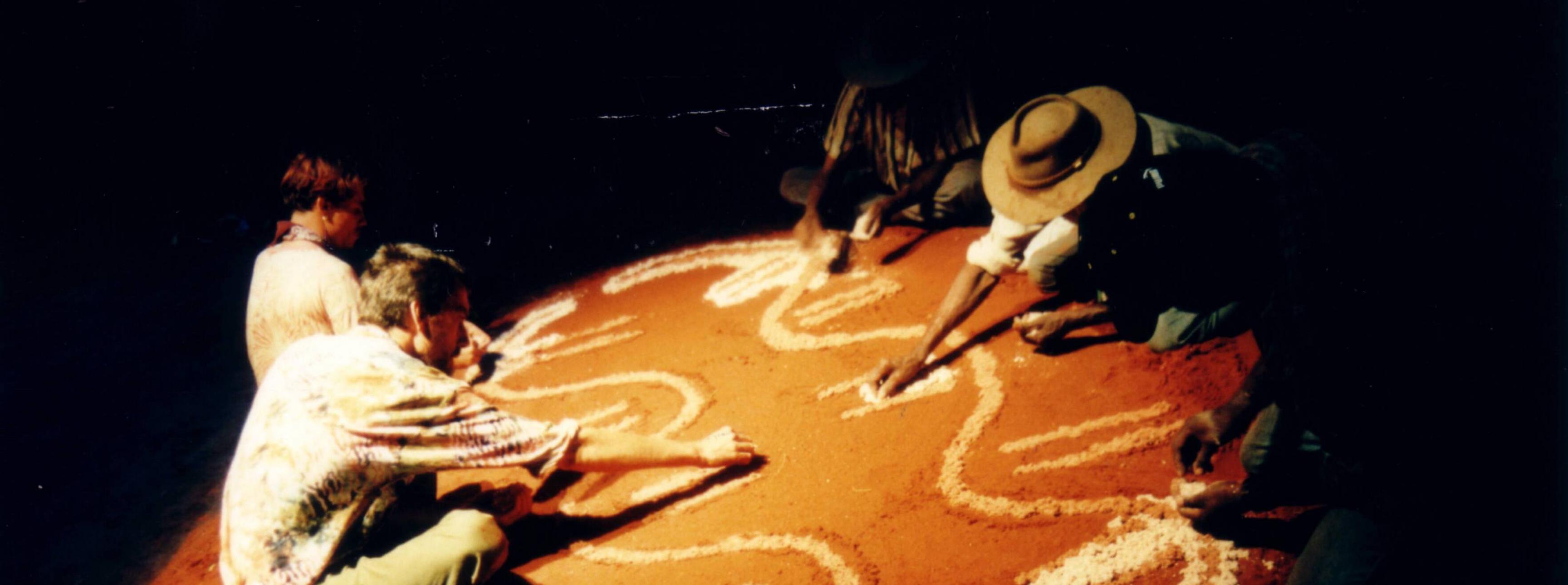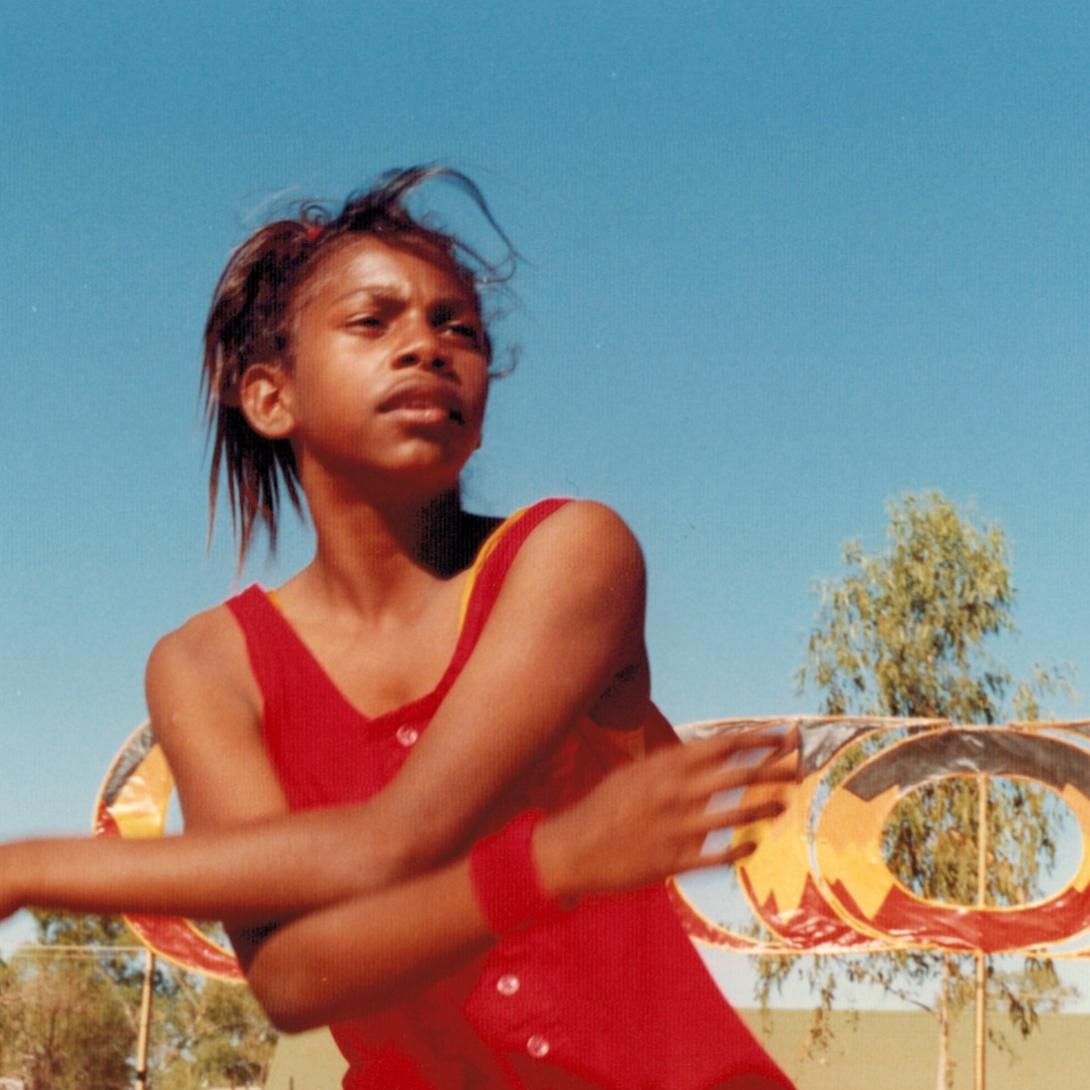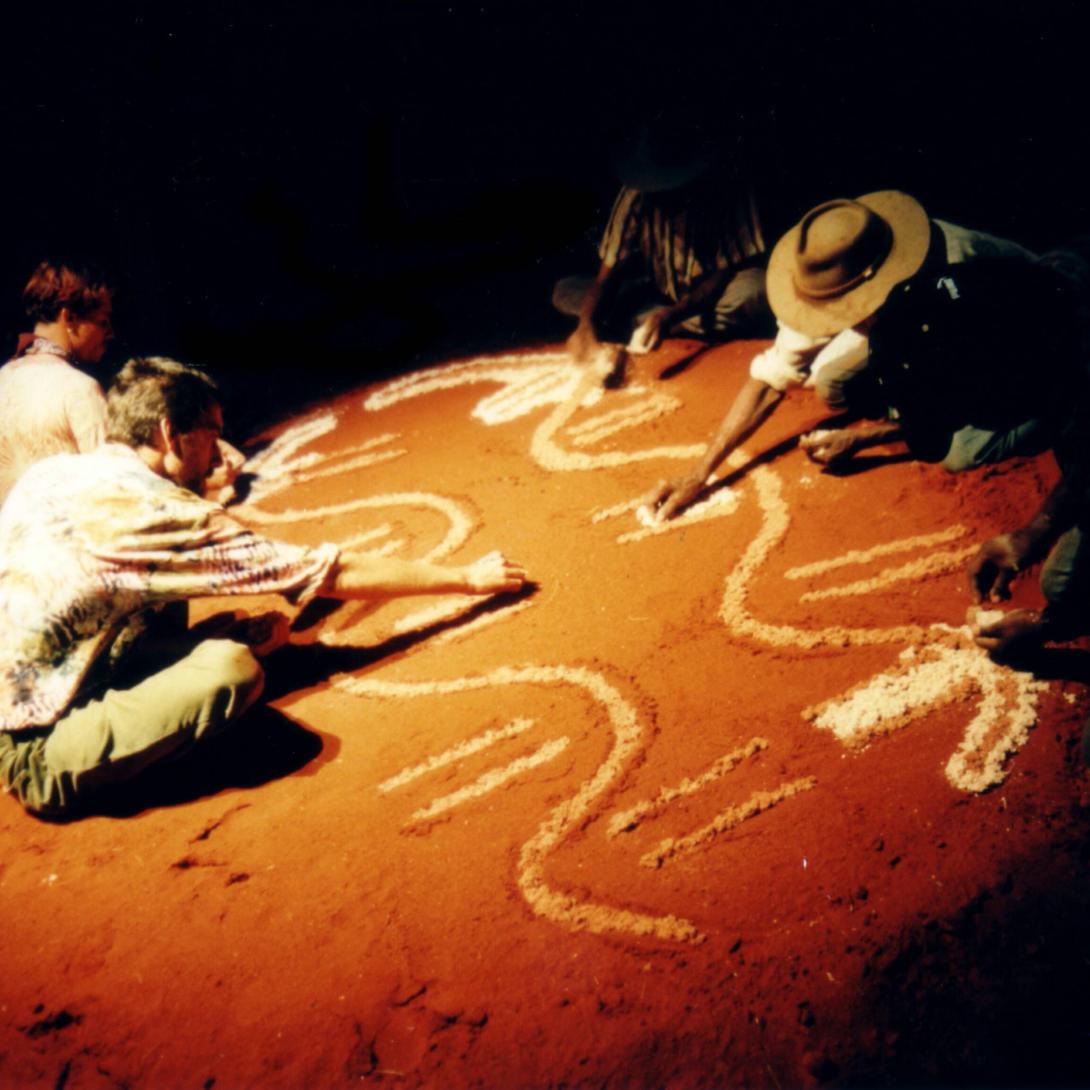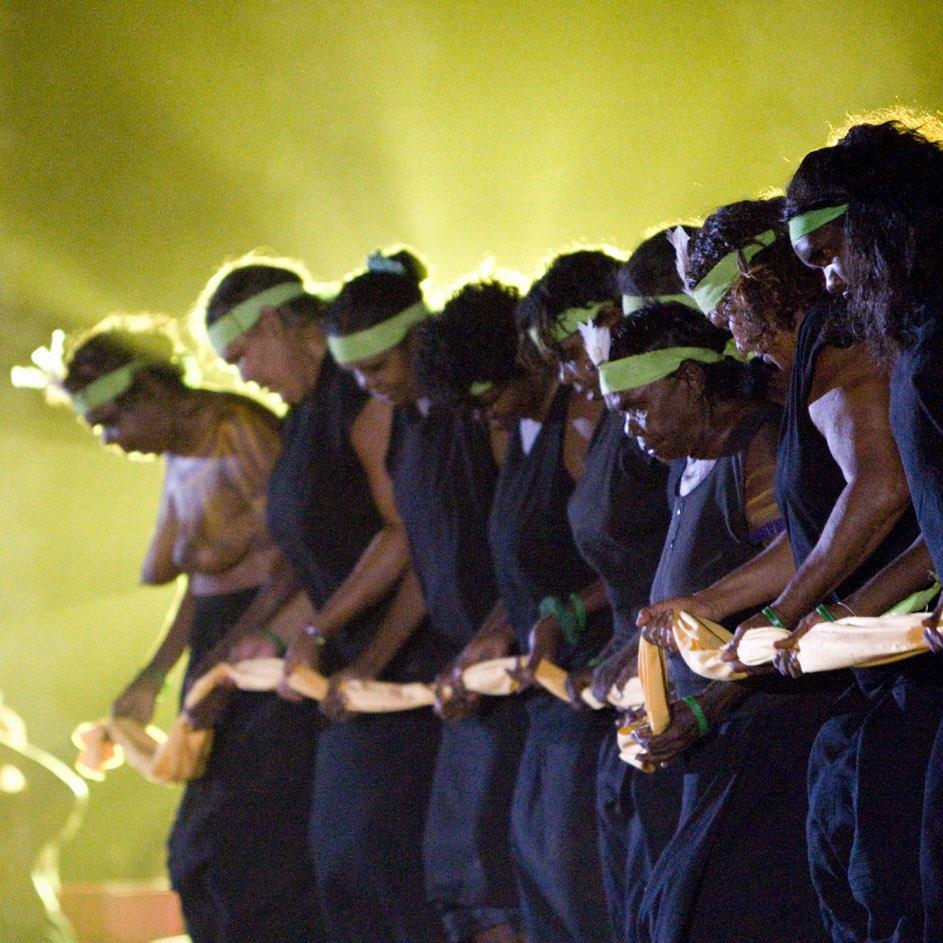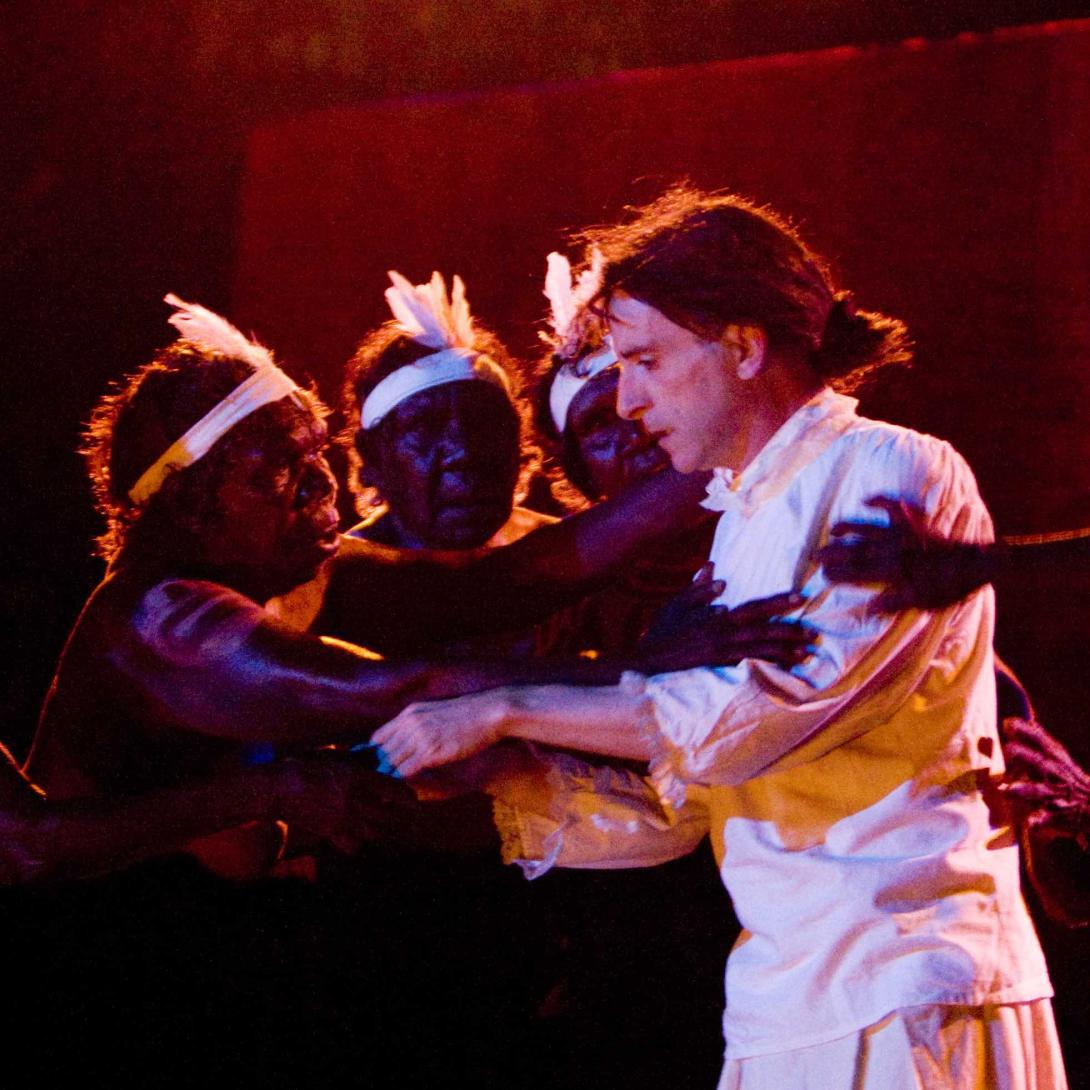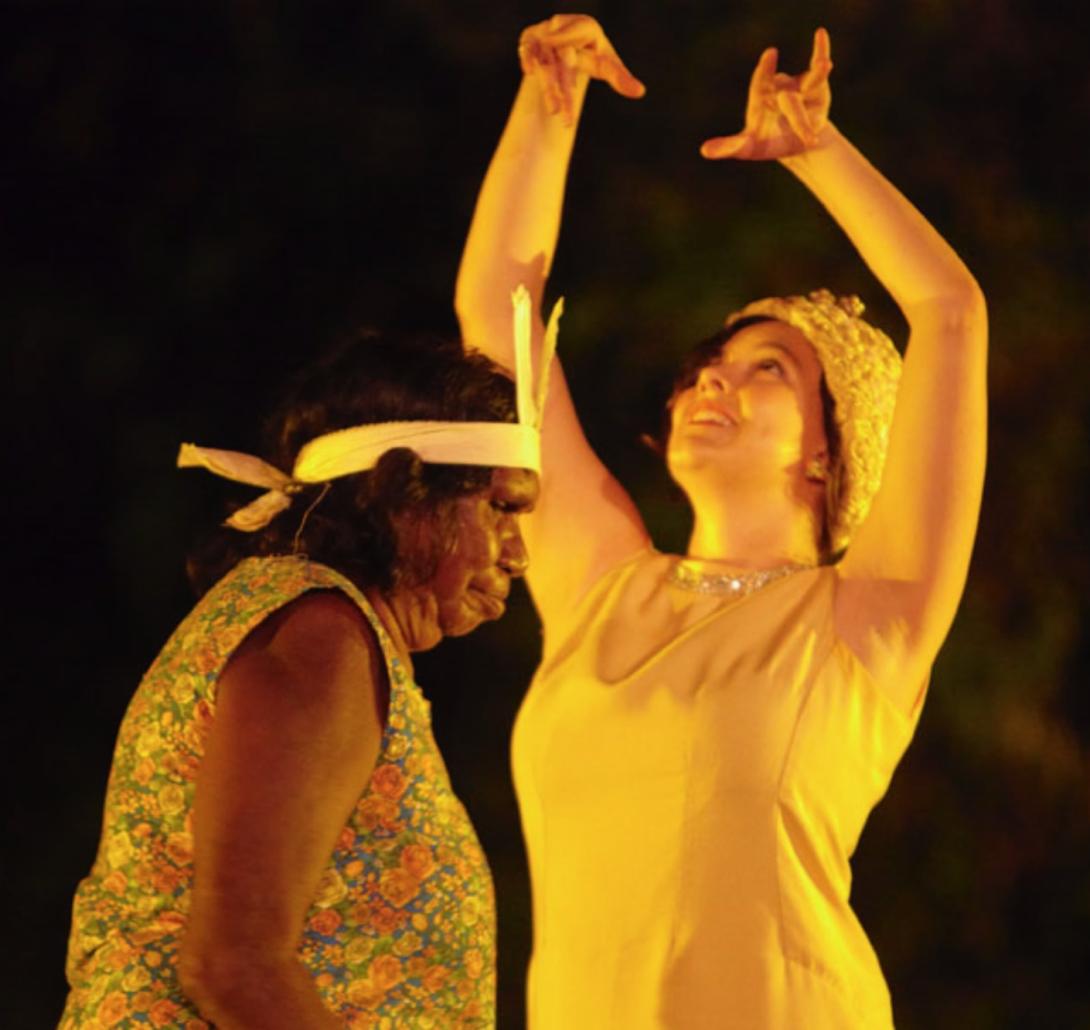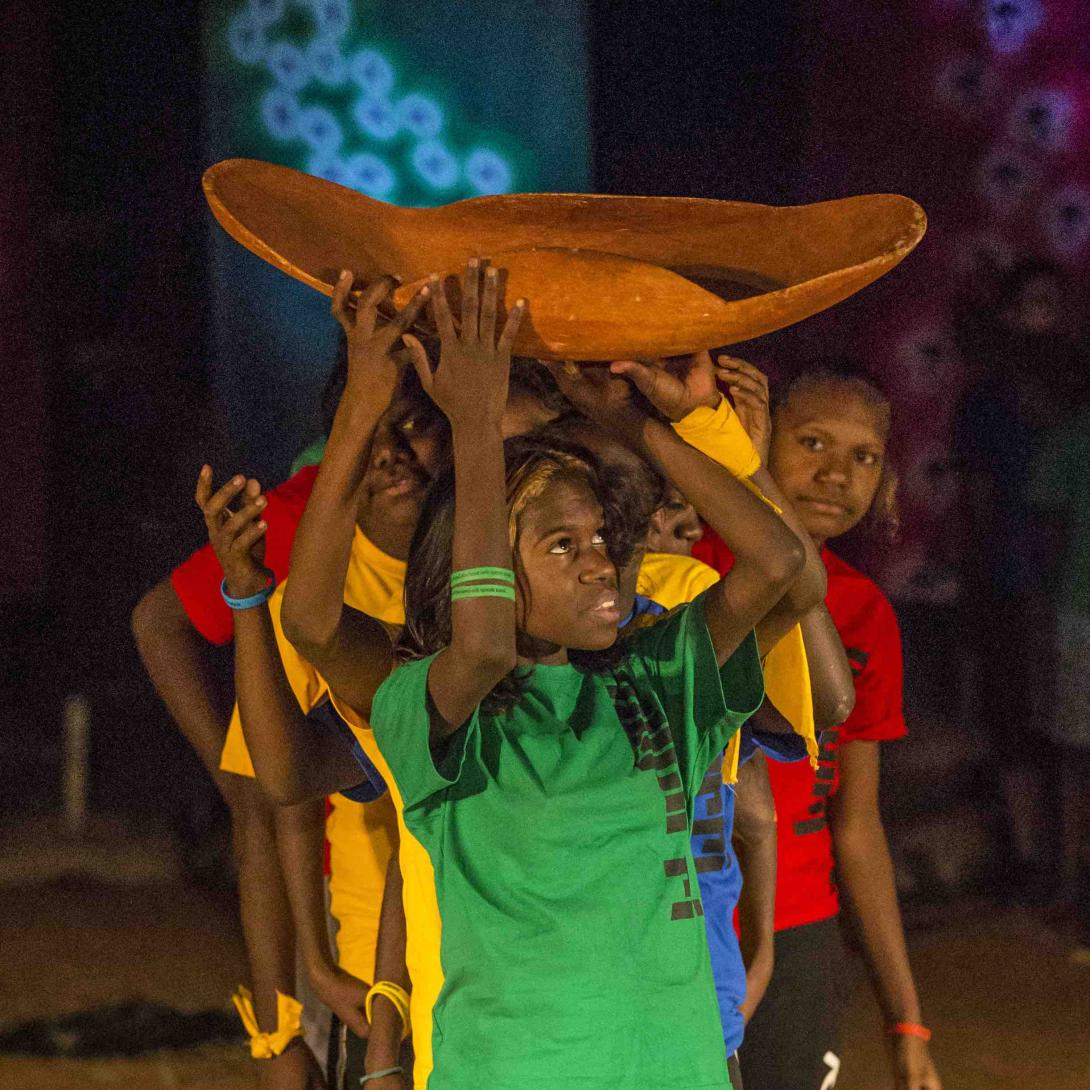LAJAMANU / TRACKS Collaborations
Trusted and Heartfelt Relationship Built Over Time
The Lajamanu Community and Tracks Dance Company collaboration began in 1988. Lajamanu and Tracks artists have been working together since then. From the outset, the connection between Dance and Visual Arts to tell stories was integral to the collaboration. What began as a youth theatre work written in Warlpiri and toured to Lajamanu, has created over 60 collaborations: from extensive residencies to touring other Warlpiri and Indigenous communities, throughout the Northern Territory and interstate. There were visual arts and banner-making projects, shared performances in major Tracks shows in Darwin, residences with the school, presentations and forums, and a variety of research projects.
“White fellas and black fellas gotta stop standing back to back (back of hands held together) but instead we need to face each other and be friends (palms of hands held together).” Jerry Patrick Jangala (Warlpiri Elder)
1988
In 1988, Tim Newth and Sarah Calver (two of the founding members of Tracks) toured a play called Desert Boy (Mannankarrawadingi Malju) as part of the Living in Isolation tour, which included a performance in Lajamanu. The play was written in Warlpiri by Lajamanu School Students and produced by Corrugated Iron Youth Theatre, (CIYT). CIYT was a subsidiary company of Brown’s Mart Community Arts based in Darwin. Sarah was the Community Dance Development Officer and the CIYT Dance Theatre Officer. Tim Newth was a freelance visual artist who specialised in work with dance companies.
The cast of Western artists had to learn the Warlpiri script. The community may have been amused by their pronunciations, but they were impressed that a group of Kartiya (white people, non-indigenous) would try to learn the language. The traditional ceremonial women (Yawulyu) insisted on performing ‘their’ dances for the cast, and the team stayed a few extra days. And thus began a relationship with this remote Indigenous community, a relationship that has now spanned over two decades
1989
Brown’s Mart receives Community Cultural Development funding to take a team of artists into a three-month Lajamanu Community Residency. The team was Janet Robertson (CIYT Artistic Director), Sarah Calver and Tim Newth, and they created spectacular giant puppets, dances and some dramatic work. They toured this work to other Central Australian communities as well as to the north.
Tim Newth stayed on in Lajamanu linking to the school and the council for a Banner and Mural Project. He worked with community members to realise banners, and murals on water tanks and buildings. For professional development he also started a Visual Arts Research Residency to study Warlpiri art, attaching himself to elder Freddy Jangala Patrick [dec], and completed in 1990.
1990
The second Lajamanu Community Residency. This time as well as the large visual images (Tim Newth creating a memorable goanna that hid the trampoline and crash mat) and dancing (Sarah Calver), circus skills were added by Robyn Laurie (ex-Circus Oz) and music by Nick Kreig. Again they toured to many Aboriginal communities and performed in Alice Springs and Darwin.
Again in 1990 Corrugated Iron Youth Theatre produced and toured another selection of young people’s plays. The Girl Who Was Taken Away From Her Family by Selma Nampijinpa was included from Lajamanu in their New Ways Old Ways Tour. Tim and Sarah again toured with the team. In Lajamanu they were beginning to build a strong reputation as artists who wanted to return.
1991
Corrugated Iron produced a dance theatre play called Mupullbah. David McMicken came to Darwin to assist Tim Newth's work on this production and rehearsals included members of the Lajamanu community who were at boarding school in Darwin. Unfortunately, none of them remained in the final production.
1992
Brown’s Mart Community Arts were again successful in gaining funds to produce a full-length dance work Lajamanu Kurra Karna Yani. A group of Lajamanu youths travelled to Darwin to create this work. They were joined in the performance by a group of Yawulyu ceremonial dancers and other elders. They also had an art exhibition of desert dot paintings, other carvings and jewellery.
The performance From Little Things Big Things Grow was the result of a residency at Yipirinya school in Alice Springs (inspired by the Lajamanu touring projects in the late 1980’s) . The school was looking for a creative way to “come together”, a difficult task when there were five different language groups and cultures, as well as many social problems attached to people living in remote places and in town camps.
1993
David and Sarah assisted in the coordination and direction of a group of Lajamanu senior women who performed in the Opening Ceremony of the Arafura Games. David took his first solo drive to Lajamanu in order to get signatures on some grant applications (950 kilometres). That year, while Tim and David were running a residency in Angurugu, Groote Eylandt, (in the Anindilyakwa community of Angurugu), it was found that the video of the Lajamanu Kurra Karna Yani show was a very useful tool, as remote community people did not have footage of themselves or other Indigenous community members performing their own work.
1994
Sacred Space was a dance work that Sarah and David created in 1994. It was based on their experiences working in remote communities, especially Lajamanu. The Lajamanu Yawulyu women perform Warlu Jukurrpa (bushfire dreaming) and had an art exhibition at the Brown’s Mart Theatre. David and Sarah also took workshops with Lajamanu students at Kormilda Boarding School.
1995
Boundaries and Beyond, 1995, saw a tour of Sacred Space and other works to Lajamanu where the company performed at the school and delivered workshops. An evening community performance was also held.
Research began for a new project called Ngapa, funded by the Hybrid Arts Committee of the Australia Council for the Arts. This project had enormous scope as it intended to travel back to Warlpiri traditional country associated with the Ngapa (Rainstorm) Dreaming. From that field trip a show was to be created. This project was very near to Tim’s heart as it was led by his community mentor and ‘father, Freddy Jangala Patrick, the man who had taken Tim under his wing both as an artist but also as a son, and taught him much about Warlpiri ways of thinking and being. Ngapa was to go back to country and listen and learn from it while travelling to sacred sites along the way. Unfortunately, Jangala was quite sick and the trip had to be postponed.
A second project at Yipirinya, After the Rain allowed Tim and David to further develop their work with a wider Warlpiri community in Alice Springs.
1996
After the sad death of Jangala, we were able to take our trip to the Ngapa sites under the guidance of Abe Jangala (dec) and some important senior women. Our first attempt saw us rained in to Lajamanu with no way out until the ground dried. The community was an island. We had to return to Darwin and later try again. Next time we were stopped by a death in the community and the women were in the “Sorry Camp”. We had to wait until they were released before we could go. We did finally go on the trip and made a performance that was shown at Brown’s Mart Theatre Darwin. (Ngapa - Artist Notes)
Tracks toured to Wangaratta and Melbourne with their Opportunity of Distance tour. In an unusual method of deciding where to tour, we were told by the Lajamanu women that we had seen their country during the Ngapa trip and that they needed to see our country. So despite the middle of winter cold, Wangaratta (Tim’s country) and Melbourne (David) audiences were privileged to see the ceremonial dancing of the Yawulyu women. Our relatives were further brought into the kinship system of the Warlpiri.
1997
e toured with the Yawulyu women to Sydney where they performed as part of the Festival of Dreaming in the lead-up to the Sydney Olympic Games. Tim and David also did a second Angurugu residency on Groote Eylandt.
1998
NAISDA (National Aboriginal Islander Skills Development Association) student and local Darwin man Stanley Stanislaus did his Indigenous Residency with us. As part of that residency, we spent time in Lajamanu running dance workshops in the school and liaising with other community members.
1999
Tim and David did a short residency in Lajamanu and presented papers based on the Ngapa project work at the Found in Translation. Conference and the University of Tasmania. We also began research into a new work about anthropologist Miss Pink. We first heard of this woman from Abe Jangala while on the Ngapa research trip. She was the first white person many of the older Warlpiri had ever seen. Tim did his research in Lajamanu while David went to Alice Springs.
2000
Another Lajamanu residency with Tim and David saw the creation of a performance in the school called Skins. The Yawulyu women made one of their regular trips to Darwin and a shared workshop with the Darwin seniors dance troupe Grey Panthers took place.
2001
Due to our difficulties explaining the contemporary nature of the traditionally based dancing coming from Lajamanu, Tim and David were funded for a research project called Between Foot and Voice in 2001. We researched both Lajamanu Warlpiri and Tiwi dancers we had worked with. The Lajamanu women created a new dance cycle based on Olive Pink (Talkinjiya) and this later contributed to the performance Fierce – The Story of Olive Pink.
2002
A new version of Fierce – The Meeting of Olive Pink was devised focussing on the Warlpiri versions of the story and toured to Alice Springs. The Between Foot and Voice research project continued with another Lajamanu trip that also allowed workshops to be given at the Education Centre. This year Tim and David also presented a paper called The Getting of Intercultural Wisdom at the Artistic Directors' Conference 2002.
2003
Celebrating 10 years of Tracks being named, the Yawulyu women came to Darwin to perform in Local, and Myra Nungarrayi Herbert was made a Life Member. Tim and David also did a project Janganpa, with Alice Springs Warlpiri – a full-length performance at the Araluen Arts Centre.
2004
We were invited to take the Yawulyu women to Tasmania with the Fierce project as part of the 10 Days on the Island Festival. This was because Miss Olive Pink was born in Hobart. This cultural exchange between the Northern Territory and the local Indigenous communities in Tasmania did not occur due to insufficient funding. But a new project was bubbling away – one that came directly from a member of the Lajamanu community.
2005
The first Milpirri performance was created – Jardiwanpa. This life-changing community dance event was the beginning of a revisioning of the way that both Western and Warlpiri values could work together. Based on the ideas held in the Ngapa Dreaming that Steve Jampijinpa Patrick was one of the owners of, a celebratory community development project united over 200 performers.
That year three Yawulyu dancers also travelled to Darwin to join us in our season of Angels of Gravity. This project reunited the women with dancer Trevor Patrick who had played the lead role in the Fierce shows. The women were also involved in the creation of multimedia work with Elka Kerkhoffs. The women also performed ceremonial dances at the Museum and Art Gallery as part of the Art on Tour Project for the Darwin Festival.
2006
With the assistance of the Potter Foundation, we were able to take two Lajamanu youths, Caleb Japanangka Patrick, and Gerard Japanangka Scobie, along with our Darwin Youth Dance Leaders, to the Australian Youth Dance Festival in Horsham, Victoria. They were also able to perform in our major youth dance show Mr Big where they were reunited with choreographer Nick Power. Nick Power and Erwin Fenis later toured to Lajamanu for a workshop series where new dances and dance films were made.
2007
Tim and David spent a week in Lajamanu devising with Steve Jampijinpa Patrick the second Milpirri festival. Taking a team down for six weeks later in the year created the next Milpirri – Kurdiji. Based on an initiation ceremony this project tells the story of mothers and sons and uses the same symbolism as we find in our national coat of arms.
2008
The Lajamanu Yawulyu women and the Grey Panthers were again united in Darwin for a season called Lipstick and Ochre, a celebration of older women. They may have come from different worlds, but both groups of women knew how to get done up and dance the night away. Caleb Japanangka Patrick and Gerard Japanangka Scobie joined the women for this performance.
That year also saw Caleb come to Darwin to perform in the award-winning show Struck, while Tim, David and Steve Patrick presented a paper at the Regional Arts Conference – Art at the Heart. The name of the paper was A Cross-Cultural Collaboration - 20 Years In The Making. Radio National ran a significant story interviewing Tim, David and Steve. Regional Arts also published a book – Big Stories – with Milpirri as one of those big stories.
In 2008 Steve Jampijinpa Patrick, Miles Holmes and (Lance) Alan Box collaborated on a publication called Ngurra-kurlu a way of working with Warlpiri people - Ngurra-kurlu is a representation of the five key elements of Warlpiri culture: Land (also called Country), Law, Language, Ceremony, and Skin (also called Kinship). It is a concept that highlights the primary relationships between these elements, while also creating an awareness of their deeper complexities. Understanding ngurra-kurlu has many benefits for Warlpiri and also for those who work with them. This idea of Ngurra-Kurlu (of feeling at home inside oneself) has become a fundamental way of explaining how and why we work in Lajmanu the way we do. It validates the Warlpiri way of thinking and explains it to others with clarity, and relevance to modern community living
2009
The Milpirri cycle continues with Milpirri – Jurntu, based on Law and Order and used the stories behind various artefacts to drive the messages home. Milpirri won the 2009 Australian Business Arts Foundation Giving Award. Caleb travelled again to Darwin to perform in our Darwin Festival work Endurance.
2010
Nick Power, Tim and David worked in Lajamanu with Caleb teaching dance workshops in the community. We then took a group of young men and boys to Melbourne to perform at the Australian Dance Awards. It was a long way from the desert community of Lajamanu to the big city lights of Melbourne and the State Theatre stage.
Myra Nungarrayi Herbert, Caleb and Gerard came to Darwin to perform in The Cook, The Queen and The Kelly. Their section was based on tall tales we had heard from men in Lajamanu saying the Queen had stolen their sacred Kurdiji symbols to create the Australian coat of arms. This show was shortlisted for the 2010 Australian Dance Award for Outstanding Achievement in Youth or Community Dance.
And finally, Caleb travelled to Sydney to participate in Platform Festival – Australia’s most prominent hip-hop festival directed by Nick Power.
2011
A smaller Milpirri took place – Milpirri Yinapaka and Jess Devereux spoke at Dance Massive National Dance Forum, Melbourne, about being a community dance artist in Lajamanu.
2012
The fifth, and last in the Milpirri cycle took place: Milpirri Pulyaranyi. We also reignited the Milpirri Banner project started in 2005, gathering more designs and converting them into further banners. It is hoped that eventually, we will have all the banners that will represent all of the families of Lajamanu.
Tim and David also joined with Steve in Alice Springs for the Same But Different Conference run by the University of New South Wales.
2013
Tim, David and Steve presented at the National Dance Forum about our long-term work together, paralleling our lives and differences, and shared commitments. They also met in Alice Springs for the second Same But Different conference. Caleb danced in our Darwin Festival show Zombies in the Banyan Tree. Kelly Beneforti and Caleb Patrick worked on a joint Early Career Residency project. Both were previous Tracks Youth Dance Leaders who had worked together on various projects since the Australian Youth Dance Festival and Mr Big in 2006. This project was in Darwin and Lajamanu and researched how their different styles of dancing had run parallel, how they affected each other, and how place had effect on choreographic inputs.
2014
The sixth Milpirri Jardiwanpa took place. This was a return to the first ceremony in the cycle.
2015
Milpirri 2014 wins the Australian Dance Award for 'Outstanding Achievement in Community Dance'. Tim Newth, Kelly Beneforti and Mat McHugh spent a week in the community establishing the upcoming 2016 Milpirri
2016
The seventh Milpirri Kurdiji. The return to the shield ceremony, a transition of boys to men, where mothers and sisters exhort the young initiates to be good members of their communities. Aaron Lim joined the team of Newth, McMicken, and Beneforti
2017
Tim, David, Kelly and Aaron returned to the community for a week of workshops in the school and community engagement.
2018
Launch of the Millpirri Banner Home Page
The eighth Milpirri Jurntu took place - a return to Law and Order and artefacts, while also spending multiple weeks in Lajamanu creating the Milpirri Soundtrack for the 2018 performance.
2019
Kelly Beneforti, Jessica Devereux, Aaron Lim and for the first time, Jordan Bretherton spent a week in Lajamanu working on a music video for the song 'Justice' created and performed by the students in Milpirri Jurntu (2018).
Dance Body Design was a project designed to bring visibility to the creative relationship between the Warlpiri people of Lajamanu and Tracks Dance Company, creating a public digital platform to hold the knowledge and documentation: the Milpirri Dances
Tim and David travelled to Europe to visit Professor Barbara Glowczewski in France, who worked in Lajamanu in the 1970s, who then travelled with a group of Lajamanu artists and dancers to Paris in the 1980s. They spent 10 days together sharing stories and looking through Barbara's archives.
2020
In April/May the equivalent of three weeks of development work took place in Darwin, Lajamanu and Melbourne. (We were to be in Lajamanu but COVID-19 biosecurity restrictions for remote Indigenous Communities stopped this). Kelly Beneforti worked with Madeleine Brown and Jordan Bretherton online and in the studio to work on protocols, historical information, and the creation of new material based on the Yinipaka themes that Steve Jampijinpa Patrick has established. They ran some online work with the students in Lajamanu.
Working with Steve Jampijinpa Patrick in Lajamanu via Zoom to gather content, Marc Peckham and Rob Tremlett (Melbourne) created the development soundtrack and lyric content. In March Steve worked with David and Tim in Darwin to develop the thematic material.
2021
Still with some COVID restrictions, a visit the community in April completed the soundtrack lyrics with the School students, and in September we were able to work with the school to create 6 themed Yinipaka dances with the students, despite very low school attendance, presented to during a school family day. The community was still not in a position to do present a full Milpirri. Consulting with the Creative Director, Steve Jampijinpa Patrick, and his father, the senior Elder Jerry Jangala Patrick, it was agreed to reshape the event to a future time when people could come together but to continue the work in the community as residences between Tracks and Lajamanu artists and community.
Ninety-three bird tracks were painted on timber cutouts by artists from the Warnayaka Arts Centre, depicting the small and high-flying birds of the Yinapaka Story. The Bird Tracks were painted in the same style as the Milpirri Banners, and the artefacts - Men and Boomerangs and Dancing Boards and Clap Sticks. Several installations took place: at local water holes near Turkey Nest and at Emu Rockhole. The last installation was a backdrop for the community performance showing.
2022
The Tracks team worked with members of the Lajamanu community to activate the knowledge found in the Yinapaka themes. They worked at the school, Warnayaka Arts Centre, and in the general community. With a focus on uninitiated youth, the dance-making made Warlpirri knowledge visible for the whole community to share and celebrate. A final Yinapaka performance took place at the Lajamanu School.
2023
For the first time off-country, the Milpirri Sensorium brings Milpirri from Lajamanu, on the northern edge of the Tanami Desert, and onto the saltwater country of the Larrakia. In a stunning outdoor venue, twenty-seven beautifully colour-coded Milpirri banners bring to life Warlpiri kinship (Warlalja) relationships. Supported by an evocative bilingual soundtrack, alongside rarely-seen performance footage.

